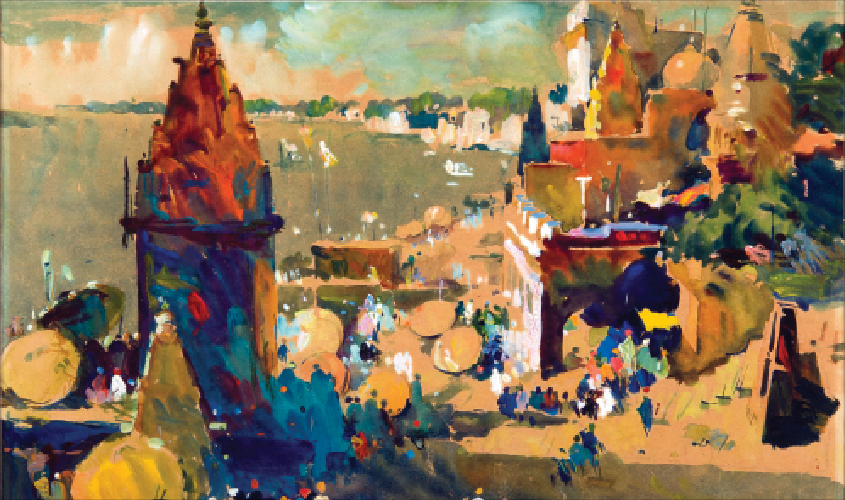A new exhibition at Mumbai’s Piramal Museum of Art centres on S.H. Raza’s early landscape paintings, which were a far cry from his trademark use of geometric abstraction and ‘bindu’ symbols in his later work, writes Bhumika Popli.
Many of us identify Sayed Haider Raza’s art with the “bindu”. His famous paintings—like Panch-Tatva, Prakriti-Purush,Surya Namaskar—feature this symbol, derived from Tantrik iconography. But Raza’s artistic repertoire went beyond the bindu. S.H. Raza: Traversing Terrains, the ongoing exhibition at Mumbai’s Piramal Museum of Art, introduces us to his lesser-known landscape paintings that preceded Raza’s decades-long engagement with geometric abstraction.
Vaishnavi Ramanathan, the show’s curator, believes Raza’s early landscapes give us a rare insight into “an artist’s evolution”. “We wanted to capture his journey. The word ‘journey’ is also a metaphor to Raza’s life because he was a constant traveller. He travelled from Madhya Pradesh to Bombay to Paris and then back to India,” says Ramanathan.
When Raza arrived from a small village—called Babariya, in the Mandla district of Madhya Pradesh—to Bombay in 1943, he was fascinated with the people and architecture of the big city. He once said, “Since I was living in the city of Bombay, which seemed very beautiful to me, I also painted Bombay, under the sun and under the rain.” He was already equipped with a formal education in painting, acquired at the Nagpur School of Art. Still, he desired to study at the Sir J.J. School of Art, where his creativity flourished. In the present exhibition, there are two paintings from his Bombay days, which display street scenes and buildings of the city. In these paintings we see Raza’s impressionist style emerge. Streets, urban landscapes, city dwellers always found a place on his early canvases, which include two of his Benaras paintings.

Raza spent a considerable part of his life in France, where he was staying in a hamlet called Gorbio, with his wife, Janine Mongillat, who was also an artist. But Raza’s engagement with French culture began before his arrival in France. In 1948, he met with the renowned French photographer Henri Cartier-Bresson in Kashmir. It was on Cartier-Bresson’s advice that Raza briefly took up cubism. His 1949 cubist painting, entitled Still Life, a gouache-on-paper, is also part of the Mumbai exhibition.
French artists in general had a big impact on Raza’s imagination. He first came across paintings by French artists at an exhibition—displaying prints of the original works—hosted at Bombay’s French Consulate in 1948. Raza was so moved by this experience that he wanted now to see the originals. So he devoted himself to learning the French language and eventually received a scholarship, in 1950, to study art in Paris. By 1956, he had won the highest French honour given to artists in that country—the Prix de la Critique Award.
About Paris, Raza once wrote, “its buildings, the atmosphere, the charged energy; it seemed to reveal at every corner that it was marvellous and was with us.” Ashok Vajpeyi, Raza close friend, visited the artist in Paris on many occasions. “At École nationale supérieure des Beaux-Arts in Paris, for a while, he was doing cityscapes and then gradually these cityscapes turned into inscapes, rather than the outside, his art becomes of the inside.”

There are paintings of cathedrals, churches and other buildings in this show, which the artist composed in Paris. Talking about one of Raza’s oil paintings, entitled Eglise et Calvaire Breton, Vaishnavi notes, “This work is one of the first paintings in which he moved from strict geometry to a more painterly language. Here he has captured the characteristic features of the Breton Calvary, such as the crucifix with figures (of saints and Virgin Mary) on either side while reducing the profusion of sculptural detail in the Calvary to daubs of paint.”
Despite all the recognition and acclaim he had won for his work, Raza was never at ease as an artist. Vajpeyi says, “Raza was apprehensive, he was thinking, ‘Where am I in this, and where is India here?’ Raza himself, about this dilemma, was quoted as saying, ‘Around 1975, I realised that I had become part of École nationale supérieure des Beaux-Arts and I was told that many French or foreign artists were doing that. I realised that my country India had a tremendous civilisation
It was once again a differnt trajectory Raza was to take in 1980 when he started painting the bindu. Vaishnavi says, “According to Raza, the phase between 1980 and 1985 was when he was reborn as a painter, a time when he could use the techniques he had mastered to explain his own perception of things.”
Most artists like to stick to tried-and-tested methods of making something, but here was someone who was constantly challenging himself, and learning almost at every stage of his life, and striving throughout to find new ways of expression.
‘S.H. Raza: Traversing Terrains’ is on view at Mumbai’s Piramal Museum of Art till 28 October.

